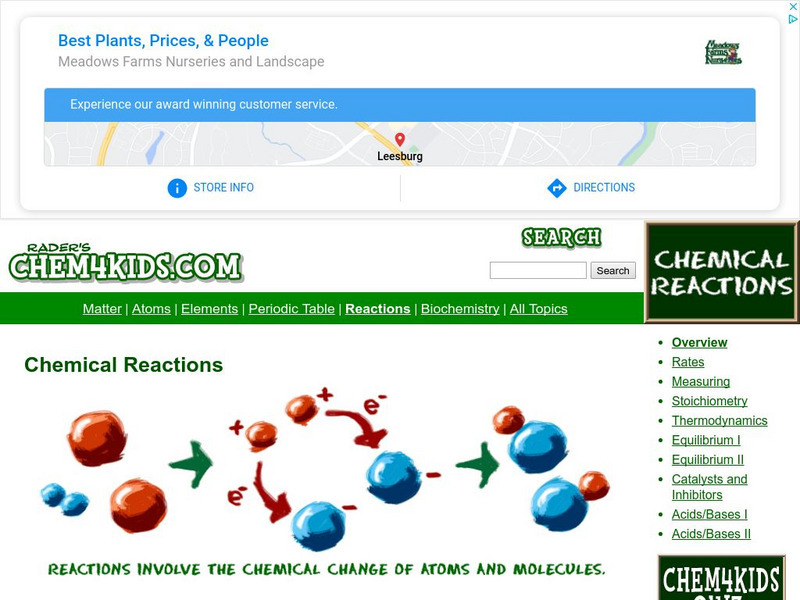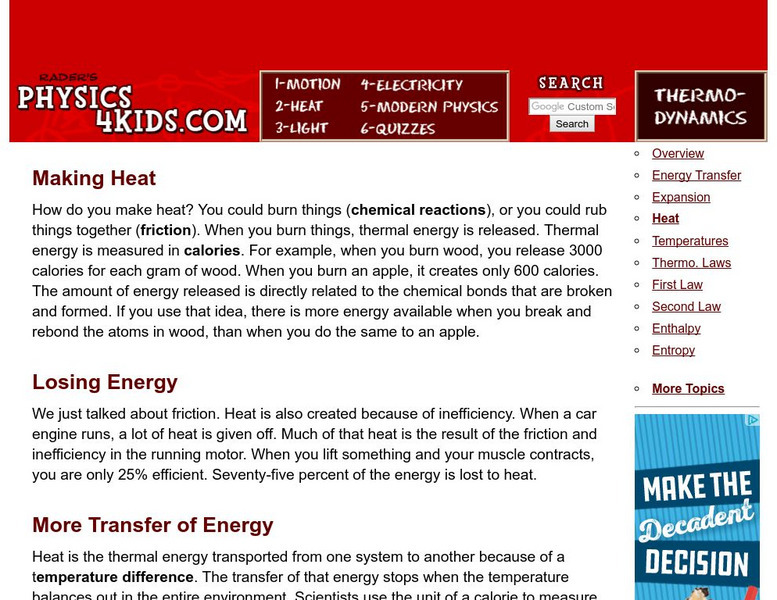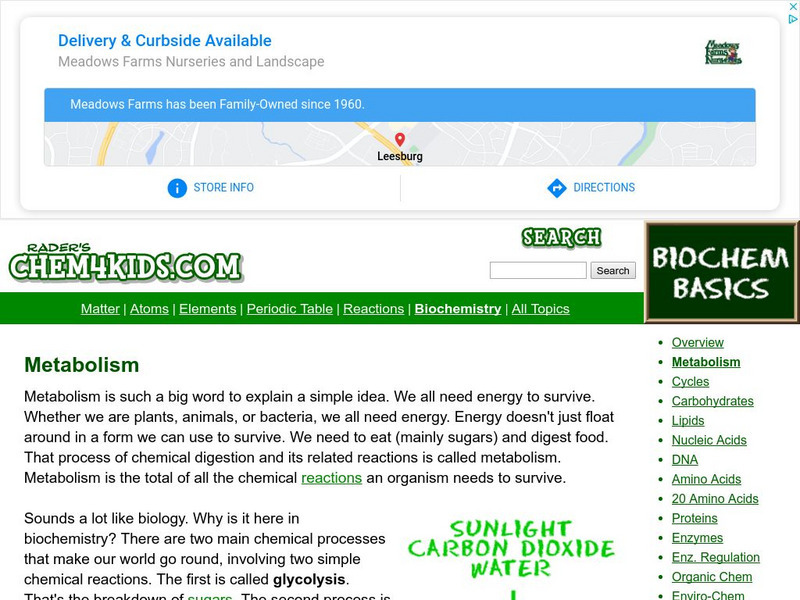Hi, what do you want to do?
PBS
Pbs News Hour Extra: The Iraq War (Students and Teachers)
This site provides coverage of the war with Iraq written for teens. Additional content includes student voices and forums.
Ducksters
Ducksters: Chemistry for Kids: Chemical Reactions
A site discussing chemical reactions in chemistry including reaction rate, types of reactions, reagents, reactants, catalysts, and inhibitors.
Ducksters
Ducksters: Physics for Kids: Energy
Kids learn about the science behind Energy including its different forms such as chemical, electrical, heat, and gravitational. When is energy considered renewable or nonrenewable?
Ducksters
Ducksters: Kids Science: Acids and Bases
Kid's learn about the science and chemistry of acids and bases on this site. Also discussed is pH level and reactions of chemicals.
Chem4kids
Chem4 Kids: Reactions
This site provides a detailed overview of chemical reactions. Content explores what a reaction is, as well as different types of reactions, reaction rates, how to measure compounds to create a reaction, and "stuff" you can add to a...
Chem4kids
Chem4 Kids: Periodic Table and the Elements
Students can use this resource to interact with the periodic table. Information is available for each element. This is a good source of information for younger students.
Other
Forms of Energy: Heat, Radiant, Electrical, Chemical, Nuclear Energy
Explains what each of these types of energy is and provides examples.
American Chemical Society
American Chemical Society: Science for Kids: Solids, Liquids and Gases
Engaging hands on science lessons for grades 2-6 on the three states of matter.
Ducksters
Ducksters: Chemistry for Kids: Chemical Mixtures
Explore all about chemical mixtures on this site including solutions, alloys, suspensions, colloids, dissolving, examples, and facts.
Ducksters
Ducksters: Chemistry for Kids: Chemical Bonding
Study chemical bonding in chemistry including atoms, valence electrons, ionic and covalent bonding, and how molecules are formed on this site!
Ducksters
Ducksters: Biology for Kids: Plant Defenses
Kids learn about plant defenses in the science of biology including cell walls, thorns, bark, chemical defenses, and even plants that fight back.
Ducksters
Ducksters: Chemistry for Kids: Chemistry Lab Equipment
Kids learn about the lab equipment used for chemistry experiments such as beakers, flasks, test tubes, stirring rods, pipettes, bunsen burners, gloves, goggles, and more.
Physics4kids
Physics4 Kids: Thermodynamics and Heat: Heat
Explains how heat is created from a chemical reaction, from friction, or from energy inefficiency, as well as the meaning of specific heat capacity.
Ducksters
Ducksters: Chemistry for Kids: Famous Chemists
Get some information about some famous chemists who made impacts on their fields! These scientists helped to develop the laws of chemistry and discovered many of the elements.
Ducksters
Ducksters: Chemistry for Kids: Soaps and Salts
Kids learn about soaps and salts in chemistry including interesting facts, how soap is made, how soap works, and what are salts in this site.
Ducksters
Ducksters: Chemistry for Kids: Glossary and Terms
Kids learn about important glossary and terms used in the science of chemistry. Words and definitions you need to know from acids to valence electrons.
Chem4kids
Chem4 Kids: Metabolism
Understand the science of metabolism with this simplified definition.
Frontiers Media
Frontiers: Brain Projects Think Big
When you read these words, hundreds of millions of nerve cells are electrically and chemically active in your brain. This activity enables you to recognize words, sense the world, learn, enjoy and create new things, and be curious about...
Other
University of Nebraska at Omaha: Brains Rule! Games: Ecstasy Invaders
Go on a mission inside a nerve cell to find out about how neurons produce and release neurotransmitters to communicate with other neurons. Learn what happens to these brain chemicals when the drug ecstasy interrupts the process.
PBS
Pbs Teachers: Rising Ice Experiment
Observe how ice and salt crystals interact by using salt to help adhere a string to the top of an ice cube in a glass of water, then lift the cube out of the water.
PBS
Pbs Teachers: Submarine Race Experiment
Balance the force of gravity with the force of the expanding gasses created by mixing baking soda and vinegar. Create a soda bottle submarine that sinks to the bottom of the bathtub and then rises back to the surface.
Curated OER
Science Kids: Science Images: Periodic Table of Chemical Elements
This is a picture of the periodic table of chemical elements, an important set of information for anyone learning about chemistry. Elements such as hydrogen, carbon, oxygen, sodium, iron and gold are listed using their chemical symbols...
Curated OER
Science Kids: Science Images: Chemical Structure of Methane
This diagram shows the chemical structure of methane. A methane molecule contains one carbon atom and four hydrogen atoms.























